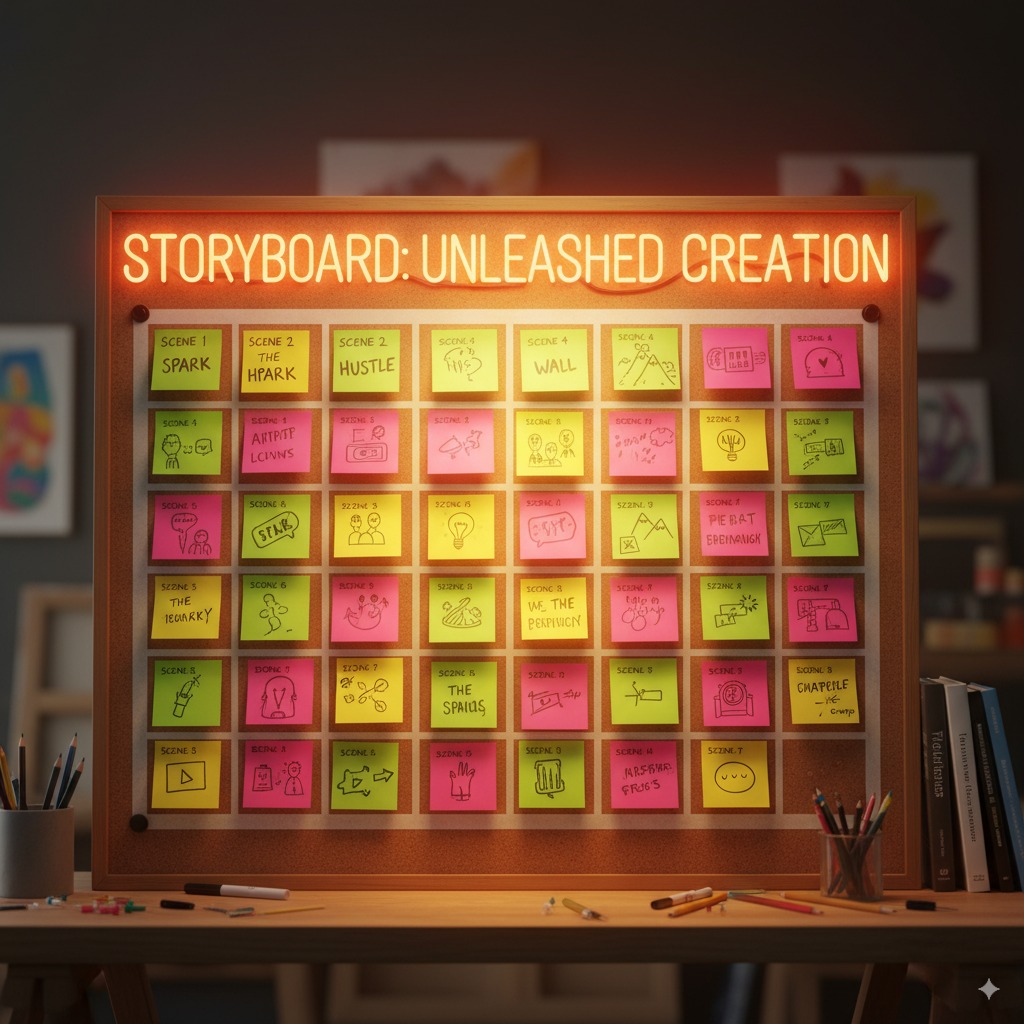The Scene That Changed Everything
The first time I broke a project into scenes instead of steps, everything clicked.
Until then, I managed work the way most people do: lists. To-do after to-do, task after task. And every list grew longer until it looked more like a punishment than a plan.
But when I reframed it as a storyboard of scenes, everything shifted. Suddenly, the project wasn’t a grind of bullet points, it was a narrative unfolding. A beginning, a middle, a climax, an ending.
That’s when I realized: projects don’t live in spreadsheets. They live in stories. And if you want your work to be memorable, you need to break it into scenes, not steps.
The Problem: Checklists Don’t Inspire
Don’t get me wrong: steps and lists are necessary. They keep us accountable. But they don’t inspire.
- Checklists flatten meaning. They tell you what to do, not why it matters.
- ADHD brains hate flat lists. A wall of bullet points is kryptonite: no urgency, no dopamine, no narrative drive.
- Audiences forget steps. Clients remember stories, not spreadsheets.
The science backs this up:
- Stanford research shows that stories are 22x more memorable than facts alone.
- Harvard Business Review reports that teams using “narrative frameworks” for projects were 50% more likely to achieve alignment and buy-in than those using only tasks and timelines.
- Cognitive psychology shows that the brain encodes events as “episodes,” not checkmarks, which is why we remember scenes from a movie but not our grocery list from yesterday.
Checklists keep you organized. Stories keep you moving.
Personal Anecdote: The Presentation That Landed
One client once asked me to deliver a highly technical deck. Their instinct was to dump everything into linear steps: process flows, compliance points, endless bullets.
If I had followed the list, the audience would’ve checked out in 10 minutes.
Instead, I rebuilt it as a story in scenes:
Scene 1: The problem (what reps were struggling with).
Scene 2: The tension (why the old process wasn’t working).
Scene 3: The breakthrough (the new strategy).
Scene 4: The payoff (what success would look like).
By the end, people weren’t just informed. They were hooked. They could retell the story back to me. That’s the power of scenes.
Framework: The Scene Method
Here’s how to turn any project into scenes:
- Find the Narrative Arc. What’s the beginning (problem), middle (tension), and end (resolution)?
- Define Key Scenes. Instead of 20 tasks, define 4–6 scenes that move the story forward.
- Visualize It. Use a storyboard, not a spreadsheet. Post-its, whiteboards, sketches.
- Write Transitions. Make sure each scene flows into the next. Momentum matters.
- Deliver the Story. Present the work as an unfolding narrative, not a sequence of chores.
This doesn’t erase steps, it gives them context.
Data: Why Scenes Work
The numbers don’t lie:
Neuroscience of narrative: Studies in Cognitive Science show the brain organizes memory around episodic “chunks,” not individual actions.
Business performance: McKinsey reports that projects framed with a narrative arc deliver 35% higher stakeholder alignment.
Education research: Lessons framed as stories improved retention in students by up to 50% compared to linear notes (Journal of Educational Psychology).
Scenes are how humans think. Steps are how machines think. Which one do you want to inspire humans with?
ADHD and Scenes as Anchors
For ADHD, scenes are lifesavers.
A wall of steps feels endless. A storyboard of scenes feels alive.
Dopamine trigger: Scenes give context, urgency, and a clear destination.
Pattern recognition: ADHD minds see big-picture arcs better than micro-tasks.
Emotional resonance: Scenes tie tasks to feelings, not just logic, which fuels motivation.
That’s why when I plan my own work, I don’t ask, “What’s step 12?” I ask, “What scene am I in right now?”
Actionable Takeaways
If you want to break free from dead checklists:
Storyboard the Project.
Write each phase as a scene title.
Label With Emotion.
Instead of “Phase 1,” call it “Scene 1: The Problem Everyone Feels.”
Add Visuals. Sketch icons, diagrams, or metaphors for each scene.
Share the Story. Present the plan to your team as a journey, not a checklist.
Anchor in the Ending. Remind people of the final scene, the vision, every step of the way.
Conclusion: Projects Are Stories
Projects aren’t lists. They’re stories.
And when you break them into scenes instead of steps, everything changes. Teams align. Clients remember. You stay motivated.
Because checklists get things done. But scenes make things undeniable.
And if you want your work, and your story, to last, build it in scenes. Always in scenes.
Still Hungry?
Don’t stop here. If this post lit a spark, you’ll want to dive into more ideas cut from the same cloth, sharper thinking, bolder design, and zero fluff.
The Day I Fired My “Inner Impostor Boss”
How ADHD magnifies impostor syndrome and what it takes to shut it down.
From Corporate Costume to Thin Creative Skin
Why hiding behind conformity kills originality and how authenticity is your new armor.
Permission Slips for Reinvention - Why no one else is going to hand you one.
Stop waiting for diplomas, managers, or permission... write your own slip.


